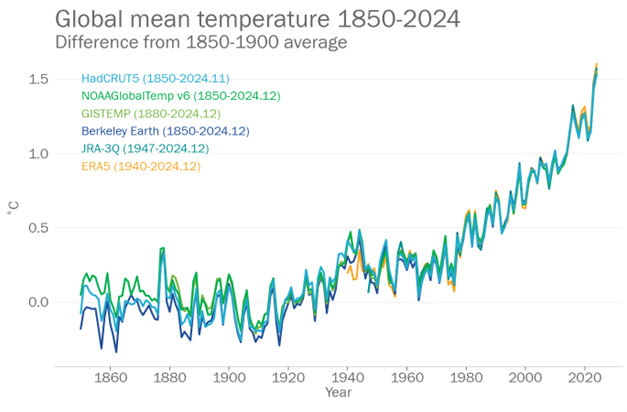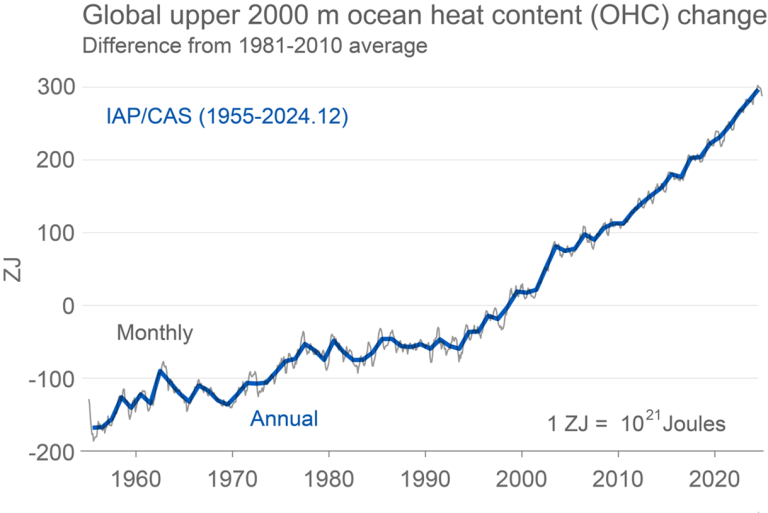According to an integrated analysis of six WMO datasets, the Earth’s average surface temperature was 1.55 °C (with an uncertainty range of ± 0.13 °C) above the 1850-1900 average. This means that for the first time ever, we are likely experiencing a calendar year in which the average global temperature is more than 1.5 degrees Celsius above the 1850-1900 average.

“Today’s assessment by the World Meteorological Organization (WMO) proves once again that global warming is a cold and hard fact,” said UN Secretary-General Antono Guterres.
“Exceeding the 1.5 degree limit every year won’t help us achieve our long-term goals, which means we’ll have to fight harder to get back on track. “We will need pioneering climate action,” he said. “There is still time to avoid the worst of climate change, but leaders must act now,” he said.
WMO provides temperature assessments based on multiple data sources to support international climate monitoring and provide reliable information for the United Nations climate change negotiation process. The dataset is a collaboration between the European Center for Medium-Range Weather Forecasts (ECMWF), the Met Office, NASA, the National Oceanic and Atmospheric Administration (NOAA), the UK Met Office and the University of East Anglia’s Climate Research Unit. (HadCRUT), and Berkeley Earth.
“Climate history is unfolding before our eyes. We’ve had not just one or two record-setting years, but a whole decade long series of catastrophic extreme weather events; With rising sea levels and melting ice, all driven by record levels of greenhouse gases from human activities,” said WMO Secretary-General Celeste Sauro.
“I would like to emphasize that exceeding 1.5°C in a single year does not mean that the long-term temperature target of the Paris Agreement has not been achieved; But rather than warming, it is measured over decades. It is essential to recognize that every inch of the degree matters: every further increase in global warming, whether below or above 1.5°C, will affect our lives, our economy, and our planet. ”, said Celeste Sauro.
All temperature ratings have some degree of uncertainty. All six datasets make 2024 the warmest year on record, highlighting the recent rate of warming. However, due to different methodologies, not all exhibit temperature anomalies greater than 1.5 °C.
The timing of the publication of the six temperature datasets was coordinated across agencies to highlight the exceptional circumstances experienced in 2024.
Another study published in Advances in Atmospheric Sciences found that ocean warming will play a key role in record high temperatures in 2024. According to a study led by Professor Lijing Cheng of the Institute of Atmospheric Physics, Chinese Academy of Sciences, the ocean is the warmest ever recorded by humans, not only at the surface but also at a depth of 2,000 meters. It involved a team of 54 scientists from seven countries and 31 research institutions.
Approximately 90% of the excess heat from global warming is stored in the oceans, making ocean heat content an important indicator of climate change. The study, based on a dataset from the Institute of Atmospheric Physics, found that from 2023 to 2024, the increase in heat content in the depths of 2,000 meters of the world’s oceans will be 16 zettajoules (1,021 joules), which is more than the global total in 2023. This is approximately 140 times the amount of electricity generated.
In its 2024 Global Climate Situation Report, scheduled to be published in March 2025, the WMO lists key climate trends such as greenhouse gases, land surface temperature, ocean heat, sea level rise, glacier retreat, and sea ice expansion. We will provide full details of the volatility indicators. It also provides details of high-impact events.

Institute of Atmospheric Physics (Chinese Academy of Sciences)



